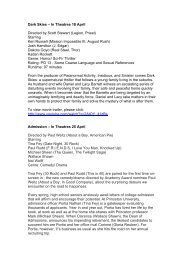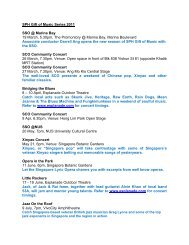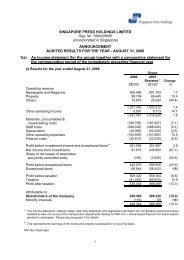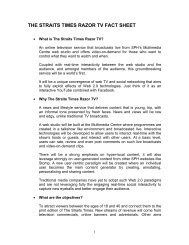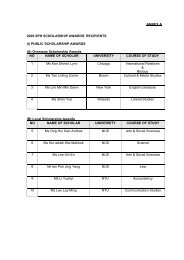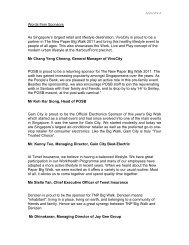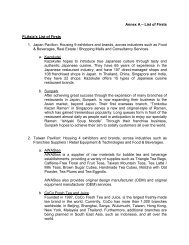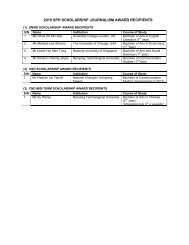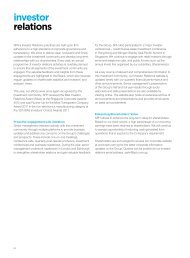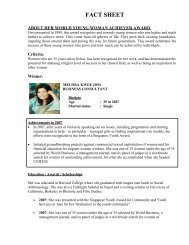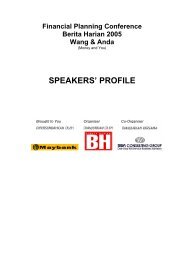S T A Y I N G A H E A D O F T H E G A M E - Singapore Press Holdings
S T A Y I N G A H E A D O F T H E G A M E - Singapore Press Holdings
S T A Y I N G A H E A D O F T H E G A M E - Singapore Press Holdings
Create successful ePaper yourself
Turn your PDF publications into a flip-book with our unique Google optimized e-Paper software.
CORPORATE GOVERNANCE REPORT (CONT’D)<br />
CORPORATE GOVERNANCE REPORT (CONT’D)<br />
BOARD COMMITTEES<br />
To facilitate effective management, certain functions have been delegated by the Board to various Board Committees.<br />
Members of the Board and each Board Committee during the financial year are set out on page 73.<br />
Executive Committee (EC)<br />
The EC comprises six members, four of whom are independent non-executive directors. The EC is chaired by the<br />
Chairman of the Board.<br />
The EC’s principal responsibilities are:<br />
1. To review, with management, and recommend to the Board the overall corporate strategy, objectives and policies of the<br />
Group, and monitor their implementation;<br />
2. To consider and recommend to the Board, the Group’s five year plan and annual operating and capital budgets;<br />
3. To review and recommend to the Board proposed investments and acquisitions of the Company and its subsidiaries<br />
which do not fall within the Company’s core businesses but which are considered strategic investments for the longterm<br />
prospects of the Company;<br />
4. To approve the affixation of the Common Seal onto any document in accordance with the Company’s Articles<br />
of Association;<br />
5. To act on behalf of the Board in urgent situations, when it is not feasible to convene a meeting of the entire Board;<br />
and<br />
6. To carry out such other functions as may be delegated to it by the Board.<br />
Audit Committee (AC)<br />
The AC comprises five members, all of whom are independent non-executive directors. All the members of the AC have<br />
many years of experience in board and senior management positions in the accounting and related financial fields. The<br />
NC is of the view that the members of the AC have sufficient financial management expertise and experience to discharge<br />
the AC’s functions.<br />
The AC performs the following main functions:<br />
1. To review annual audit plans and audit reports of external and internal auditors;<br />
2. To review the auditors’ evaluation of the system of internal accounting controls;<br />
3. To review the balance sheet and profit and loss account of the Company and the consolidated balance sheet and profit<br />
and loss account of the Group before they are submitted to the Board for its approval;<br />
4. To review the scope, results and adequacy of the internal audit function, procedures and its cost effectiveness;<br />
5. To review any interested person transactions as defined under the <strong>Singapore</strong> Exchange Listing Manual;<br />
6. To review the independence, objectivity and cost effectiveness of the external auditors and the nature and extent of nonaudit<br />
services supplied by the external auditors so as to balance the maintenance of objectivity and value for money;<br />
and<br />
7. To recommend to the Board the appointment of external auditors.<br />
The AC has conducted an annual review of the volume of non-audit services to satisfy itself that the nature and extent of<br />
such services will not prejudice the independence and objectivity of the external auditors before confirming their re-nomination.<br />
The AC meets with the external and internal auditors, without the presence of management, at least once year.<br />
Internal Controls<br />
In the course of their statutory audit, the Company’s external auditors will highlight any material internal control<br />
weaknesses which had come to their attention in carrying out their normal audit which is designed primarily to enable<br />
them to express their opinion on the financial statements. Such material internal control weaknesses noted during their<br />
audit, and recommendations, if any, by the external auditors are reported to the AC.<br />
The Internal Audit division (IAD) has an annual audit plan, which complements that of the external auditors. IAD’s plan<br />
focuses on material internal control systems including financial, operational, IT and compliance controls, and risk<br />
management. IAD also provides advice on security and control in new systems development, recommends improvements<br />
to effectiveness and economy of operations, and contributes to risk management and corporate governance processes.<br />
Any material non-compliance or lapses in internal controls together with corrective measures are reported to the AC.<br />
64 65




